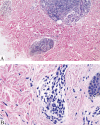Acral pseudolymphomatous angiokeratoma: case report and literature review
- PMID: 24346876
- PMCID: PMC3875970
- DOI: 10.1590/abd1806-4841.20132413
Acral pseudolymphomatous angiokeratoma: case report and literature review
Abstract
The authors describe a case of a female patient with Acral Pseudolymphomatous Angiokeratoma of Children, known as APACHE. It is a rare benign cutaneous disease, of unknown etiology, characterized by multiple, asymptomatic erythematous-violaceous papules and nodules, usually located unilaterally with acral distribution. Today, this denomination is questionable, since there are published reports of this disease in adults and in different locations. Clinically, it is similar to an angiokeratoma, whereas hystologically, it corresponds to a distinct type of pseudolymphoma. The immunohistochemical study is required to distinguish APACHE from cutaneous lymphoma.
Relata-se o caso de uma paciente com diagnóstico de angioqueratoma pseudolinfomatoso acral, conhecido por sua sigla em inglês APACHE - Acral Pseudolymphomatous Angiokeratoma of Children. É uma doença cutânea benigna, rara, de etiologia desconhecida, caracterizada por múltiplas pápulas e nódulos eritêmato-violáceos assintomáticos, de localização geralmente unilateral e acral. Atualmente, questiona-se esta denominação, já que há relatos na literatura do quadro em adultos e em outras localizações. Clinicamente, é similar a um angioqueratoma, porém, histologicamente, corresponde a um tipo distinto de pseudolinfoma. O estudo imuno-histoquímico é necessário para diferenciação dos linfomas cutâneos.
Conflict of interest statement
Conflict of Interest: None
Figures




Similar articles
-
Acral pseudolymphomatous angiokeratoma of children (APACHE): a case report and immunohistological study.Br J Dermatol. 1991 Apr;124(4):387-8. doi: 10.1111/j.1365-2133.1991.tb00605.x. Br J Dermatol. 1991. PMID: 2025562
-
Linear acral pseudolymphomatous angiokeratoma of children with associated nail dystrophy.Dermatol Online J. 2015 Jul 15;21(7):13030/qt9kt5z5gw. Dermatol Online J. 2015. PMID: 26436972
-
Acral pseudolymphomatous angiokeratoma of children in an elderly man: report of a case and review of the literature.Int J Dermatol. 2010 Feb;49(2):184-8. doi: 10.1111/j.1365-4632.2009.04203.x. Int J Dermatol. 2010. PMID: 20465644 Review.
-
Use of topical rapamycin in acral pseudolymphomatous angiokeratoma of children (APACHE): A report of two cases and review of the literature.Pediatr Dermatol. 2020 Sep;37(5):877-880. doi: 10.1111/pde.14240. Epub 2020 Jun 26. Pediatr Dermatol. 2020. PMID: 32588464 Review.
-
[Acral pseudolymphomatous angiokeratoma of children (APACHE)].Hautarzt. 2005 Mar;56(3):270-2. doi: 10.1007/s00105-004-0784-6. Hautarzt. 2005. PMID: 15580454 German.
Cited by
-
Pseudomalignancies in Children: Histological Clues, and Pitfalls to Be Avoided.Dermatopathology (Basel). 2021 Aug 14;8(3):376-389. doi: 10.3390/dermatopathology8030042. Dermatopathology (Basel). 2021. PMID: 34449607 Free PMC article. Review.
-
Localized eruptive acquired multiple angiokeratomas with spontaneous resolution in a healthy child.JAAD Case Rep. 2022 Aug 11;28:90-93. doi: 10.1016/j.jdcr.2022.07.046. eCollection 2022 Oct. JAAD Case Rep. 2022. PMID: 36117780 Free PMC article. No abstract available.
References
-
- Ramsay B, Dahl MC, Malcolm AJ, Wilson-Jones E. Acral pseudolymphomatous angiokeratoma of children. Arch Dermatol. 1990;126:1524–1525. - PubMed
-
- Freire FMZ, Filho JBS, Cintra LC, Diniz LM. Acral pseudolymphomatous angiokeratoma - a case report. An Bras Dermatol. 2006;81:S277–S280.
-
- Okada M, Funayama M, Tanita M, Kudoh K, Aiba S, Tagami H. Acral angiokeratoma-like pseudolymphoma: one adolescent and two adults. J Am Acad Dermatol. 2001;45:S209–S211. - PubMed
-
- Murakami T, Ohtsuki M, Nakagawa H. Acral pseudolymphomatous angiokeratoma of children: a pseudolymphoma rather than an angiokeratoma. Br J Dermatol. 2001;145:512–514. - PubMed
-
- Hagari Y, Hagari S, Kambe N, Kawaguchi T, Nakamoto S, Mihara M. Acral pseudolymphomatous angiokeratoma of children: immunohistochemical and clonal analyses of the infiltrating cells. J Cutan Pathol. 2002;29:313–318. - PubMed
Publication types
MeSH terms
LinkOut - more resources
Full Text Sources
Other Literature Sources
Medical
